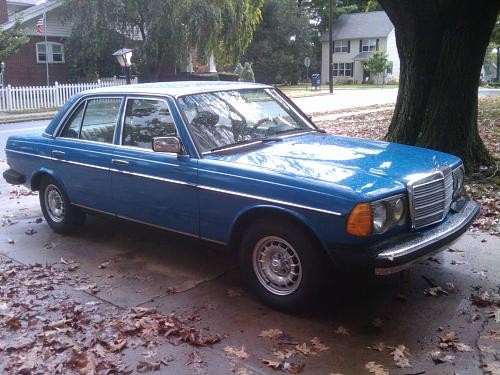For enthusiasts of classic cars that seamlessly blend affordability with daily usability, the Mercedes-Benz W123 series, particularly the 300D Turbo Diesel variant, stands out as a prime example. Produced for the US market from 1977 to 1985, the W123 embodies Mercedes-Benz’s revered “The Best or Nothing” philosophy from a bygone era. While the modern Mercedes strives to recapture this ethos, the W123 remains a tangible representation of those values. Many yearn for a brand-new W123 today, appreciating its exceptional road feel, balanced handling, renowned comfort, inherent durability, and steadfast reliability, all within a practical size. This reliability, however, is intrinsically linked to diligent maintenance, especially consistent oil changes and valve adjustments. Since new models are no longer an option, the search for well-maintained vintage examples continues, like this distinctive blue 300DT, previously listed on Benzworld for a compelling $3200.
The W123 series, especially the diesel models, are celebrated for their remarkable longevity, often accumulating hundreds of thousands of miles. However, this resilience sometimes leads to neglect, where owners prioritize mechanical upkeep for basic functionality, overlooking comfort and aesthetic aspects. Despite potential wear and tear, the inherent quality of these vehicles means they can be revitalized to excellent condition both inside and out with reasonable care. Even with signs of past use or minor damage, a wealth of original Mercedes parts remains available, and for discontinued components, numerous Mercedes-Benz salvage yards across the nation offer alternatives.
Prospective W123 owners should be aware of common failure points. Rust is paramount; these cars, not initially designed for robust rust protection, are particularly susceptible in regions with snow and road salt. Critical areas include the front valance, rocker panels (especially around jacking points), fender and door bottoms, areas around beltline moldings, lower rear quarter panels, and rear door openings. A comprehensive body inspection is crucial as rust can appear anywhere. Interior issues often stem from water leaks due to deteriorated window seals or blocked drainage channels, typically manifesting as water accumulation in the rear footwells, leading to damp carpets and a persistent musty odor. Cracked dashboards are another common ailment, particularly in blue interiors, although dash caps offer a cosmetic fix, they are not a true substitute for an original dashboard.
This specific blue 300D Turbo Diesel is particularly appealing because it reportedly addresses rust concerns, though the quality of the repair warrants scrutiny. The interior boasts remarkably clean MB-Tex upholstery, an unusual find in cars with parchment interiors which often show significant wear. For many enthusiasts, the turbodiesel engine is the definitive choice for the W123. While not as potent as the M110 2.8 DOHC inline-6, it offers superior fuel economy and reduced mechanical stress, suggesting enhanced long-term durability. Despite being a diesel, performance is still respectable, achieving 0-60 mph in approximately 11-13 seconds, with a top speed around 100 mph, and comfortable cruising at 80 mph.
If considering purchasing this 300D Turbo Diesel, replacing the US-spec sealed-beam headlights with the more effective rectangular European headlights would be a worthwhile upgrade for enhanced safety and aesthetics. While opinions vary, European headlights offer superior illumination. Aftermarket sets, including bulbs and turn signals, are available for under $300. Beyond this, the seller notes near-complete functionality, with the tachometer being the primary exception, a common issue potentially linked to the tach amplifier. A significant unanswered question is the operational status of the automatic climate control system. The asking price aligns with market value for a well-maintained 300DT with 260,000 miles, assuming no major hidden issues. For those seeking a classic car that is distinctive and practical for regular driving, offering much of the comfort found in modern vehicles, the 300D Turbo Diesel is a compelling option. Alternatively, the seller also offered a 1986 300E with orthopedic seats for those preferring a gasoline engine.
